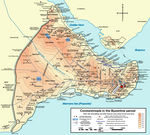Marmara Region
Marmara RegionRegions of Turkey

The Marmara Region (Turkish: Marmara Bölgesi) is a geographical region of Turkey. Located in northwestern Turkey, it is bordered by Greece and the Aegean Sea to the west, Bulgaria and the Black Sea to the north, the Black Sea Region to the east, and the Aegean Region to the south. At the center of the region is the Sea of Marmara, which gives the region its name. The largest city in the region is Istanbul. Among the seven geographical regions, the Marmara Region has the second-smallest area, yet the largest population; it is the most densely populated region in the country.
Excerpt from the Wikipedia article Marmara Region (License: CC BY-SA 3.0, Authors, Images).Marmara Region
Istanbul
Geographical coordinates (GPS) Address Website Nearby Places Show on map
Geographical coordinates (GPS)
| Latitude | Longitude |
|---|---|
| N 41 ° | E 29 ° |
Address
İstanbul
34126 Istanbul
Türkiye
Open on Google Maps







